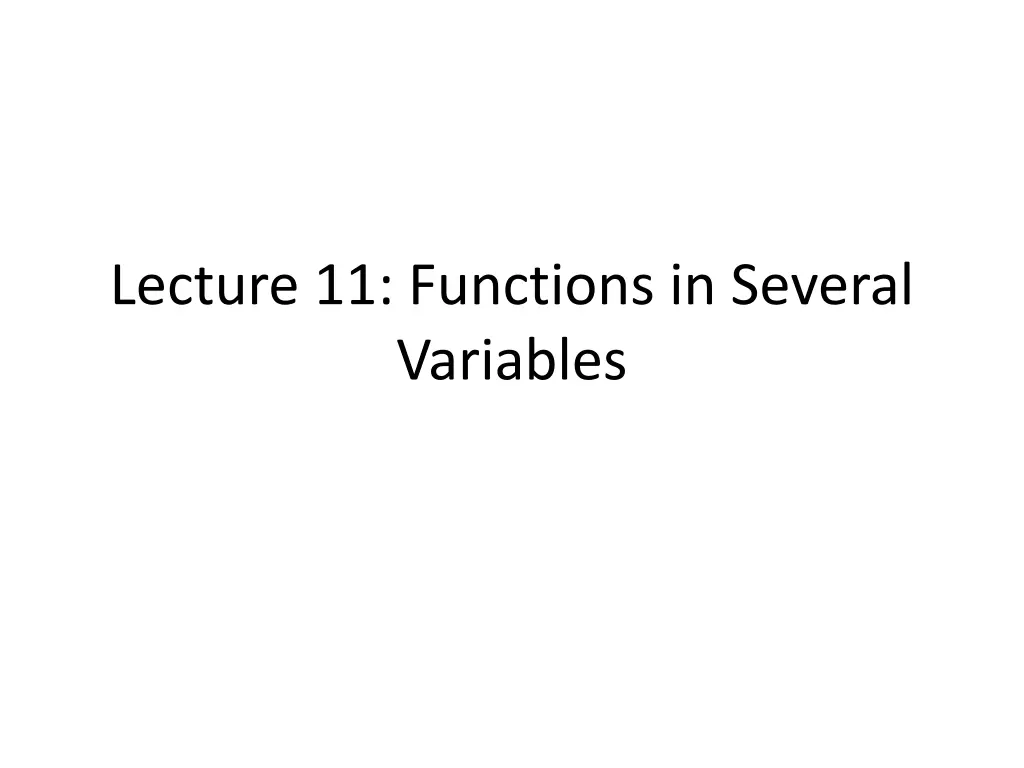
Understanding Functions in Several Variables
Explore functions in several variables, including domains, level curves, continuity, and sketching techniques. Learn about multivariable functions and their domains, continuity requirements, and how to sketch functions of two variables using level curves.
Uploaded on | 3 Views
Download Presentation

Please find below an Image/Link to download the presentation.
The content on the website is provided AS IS for your information and personal use only. It may not be sold, licensed, or shared on other websites without obtaining consent from the author. If you encounter any issues during the download, it is possible that the publisher has removed the file from their server.
You are allowed to download the files provided on this website for personal or commercial use, subject to the condition that they are used lawfully. All files are the property of their respective owners.
The content on the website is provided AS IS for your information and personal use only. It may not be sold, licensed, or shared on other websites without obtaining consent from the author.
E N D
Presentation Transcript
Lecture 11: Functions in Several Variables
Part I: Domain of functions of several variables and level curves
Objectives Objectives: Know how to find the domain of functions of several variables Know how to sketch level curves for functions of two variables. Corresponding Section in Simmons: 19.1
Functions in Several Variables So far, we have considered functions ?(?) whose value only depends on one variable ?. We now consider functions such as ?(?,?), ?(?,?,?), etc. whose value depends on several variables. Example: ? ?,? = ??
Domain of Multivariable Functions For functions ?(?,?) of two variables, the domain is now a region in the plane 1 Example: for the function ? ?,? = ? ?, the domain is the entire plane minus the line ? = ? Example: for the function ? ?,? = the domain is the first quadrant. For functions of n variables, the domain will be a space in n dimensions. ? + ?,
Continuity In order for a function ? of several variables to be continuous at a point p, it must approach ? ? no matter which direction p is approached from. Example: If ?(?,?) is 0 when ? = 0 or ? = 0 and 1 otherwise, ? is not continuous at (0,0). Although ? appears continuous along the lines x = 0 and ? = 0, it is not continuous along other lines.
Sketching Multivariable Functions How can we sketch functions of two variables? We can sketch the level curves where the function has the same value. These curves will be functions of one variable. Example: If ? ?,? = ?? then the level curves are of the form ?? = ? which is described by the single variable equation ? = ? ?
Example: ? ?,? = ?? 6 5 4 3 f=-4 f=4 2 1 f=-1 f=1 y 0 -1 -2 -3 -4 -5 -6 f=-1 f=1 f=4 f=-4 -6 -5 -4 -2 0 1 2 3 4 -3 -1 5 6 x
Part II: Partial Derivatives, Directional Derivatives, and the Gradient
Objectives Objectives: Know how to find directional derivatives partial derivatives, and the gradient. Know what it means for a multivariable function to be differentiable.
Partial Derivatives What does it mean to take the derivative of a function ? of several variables? One idea: Partial derivatives. Partial derivatives treat ? as a function of one variable by treating every other variable as a constant. Example: If ? ?,? = ?? then ?? ??= ? and ?? ??= ?
Directional Derivatives We can also look at how much ? changes when we move in a particular direction Def: The directional derivative ? ? ?? = lim 0 Example: If ? ?,? = ?? and ? =< 1,1 > then ? ??,? = lim 0 Example: ? ??= ??? ?(?) is ? ?+ ? ?(?) ?+ ?+ ?? = ? + ? ??
Directional Derivatives Cont. How can we describe the directional derivative for all directions? Example: If ? ?,? = ??, (?+? )(?+? ) ? <?,?>?,? = lim = ?? + ?? 0 ? <?,?>?,? = < ?,? > < ?,? >
Directional Derivative Linearity If the directional derivatives behave linearly, everything is well-behaved ? ?? ?? ? ?? ? +?? ? ?+? ,?+? ? ?,? =?? ??? +?? lim 0 ??? <?,?>?,? =<?? ??,?? ? ??> < ?,? >
Gradient ?? ??1, ?? ??2, , ?? ???> Def: ?? =< If the directional derivatives behave linearly, ? ?? = ?? ? ?? describes both the direction in which ? increases most quickly and how much it increases by
Examples If ? ?,? = ?? then ?? =< ?,? > ?2 ?+? then ?? =< 2? ?+?> If ? ?,?,? = ?2 (?+?)2, ?2 (?+?)2,
Differentiability We say that ? is differentiable at ? if the directional derivative behaves linearly Warning: It is not enough for the directional derivative to exist in all directions. Example: ?2? ?2+?2 Sufficient condition for differentiability: If all partial derivatives exist and are continuous, the function is differentiable. ? ?,? =
